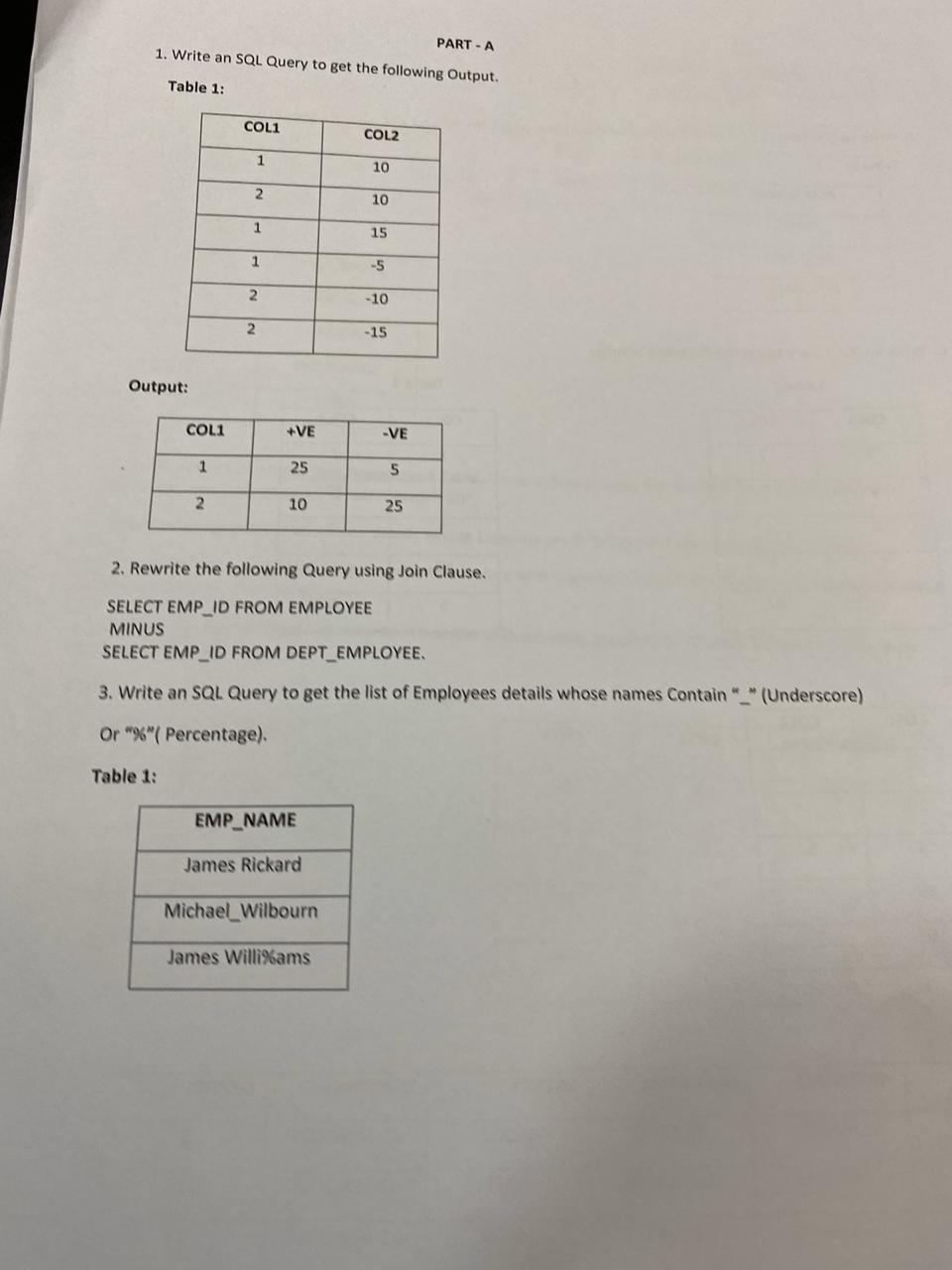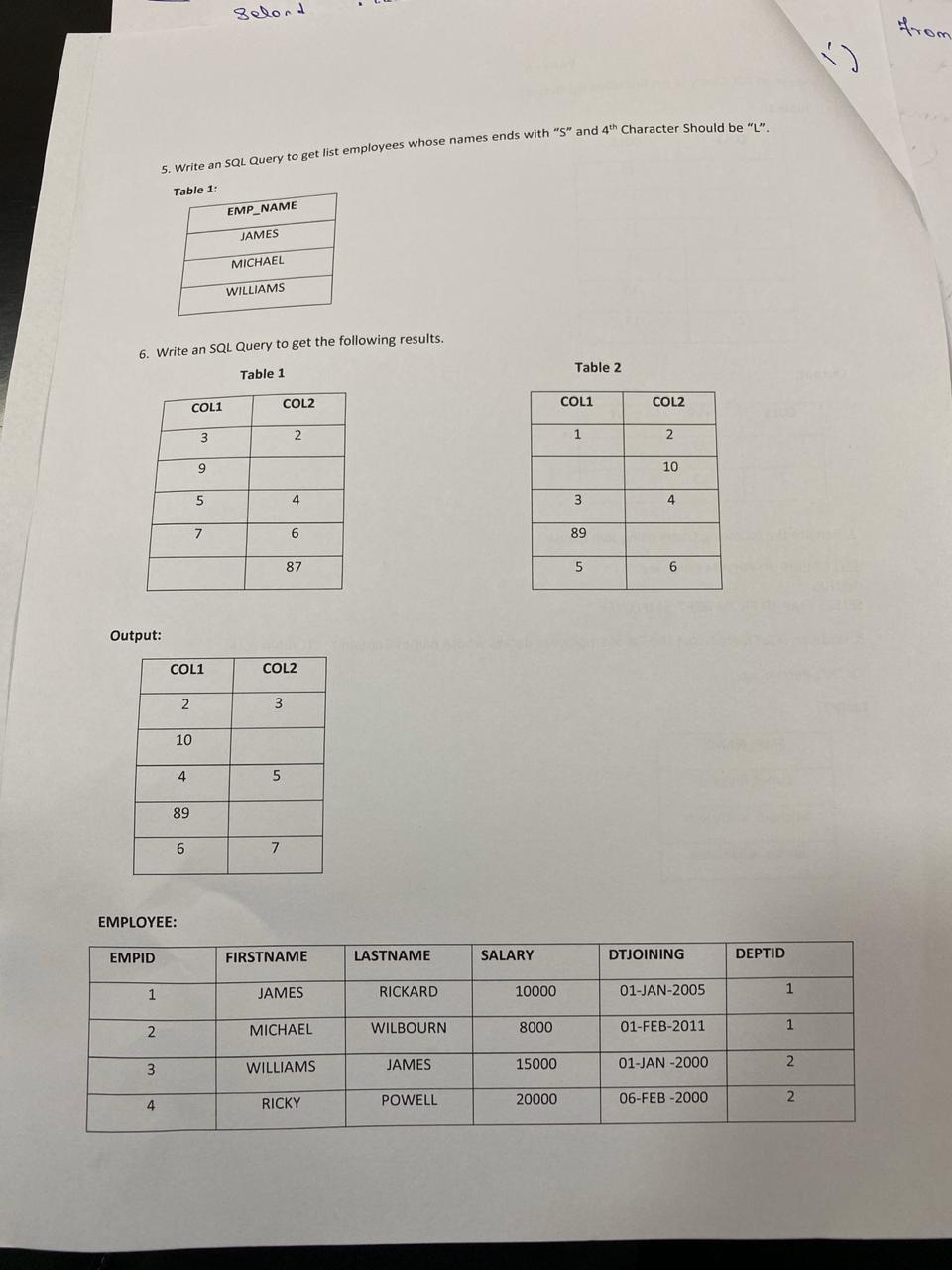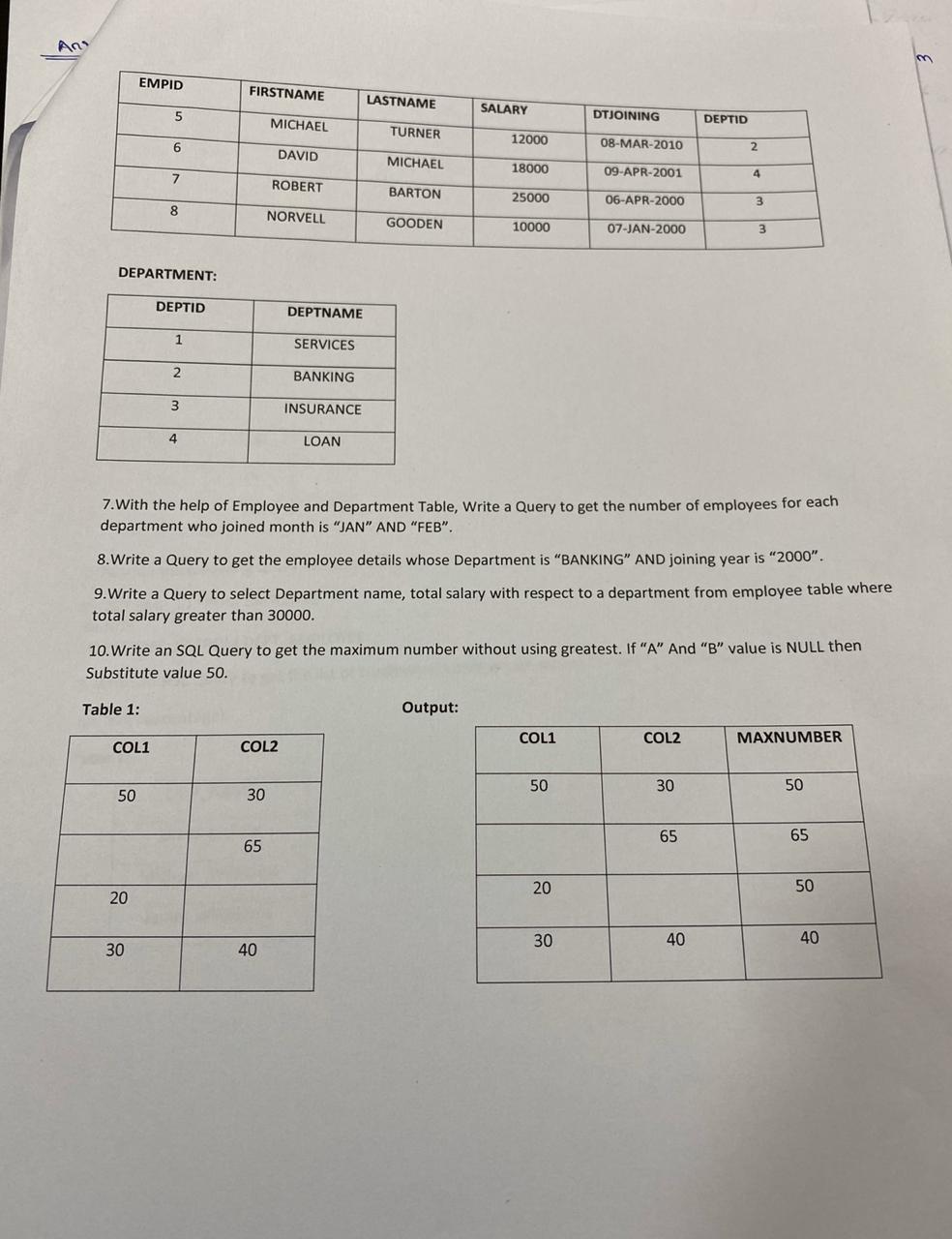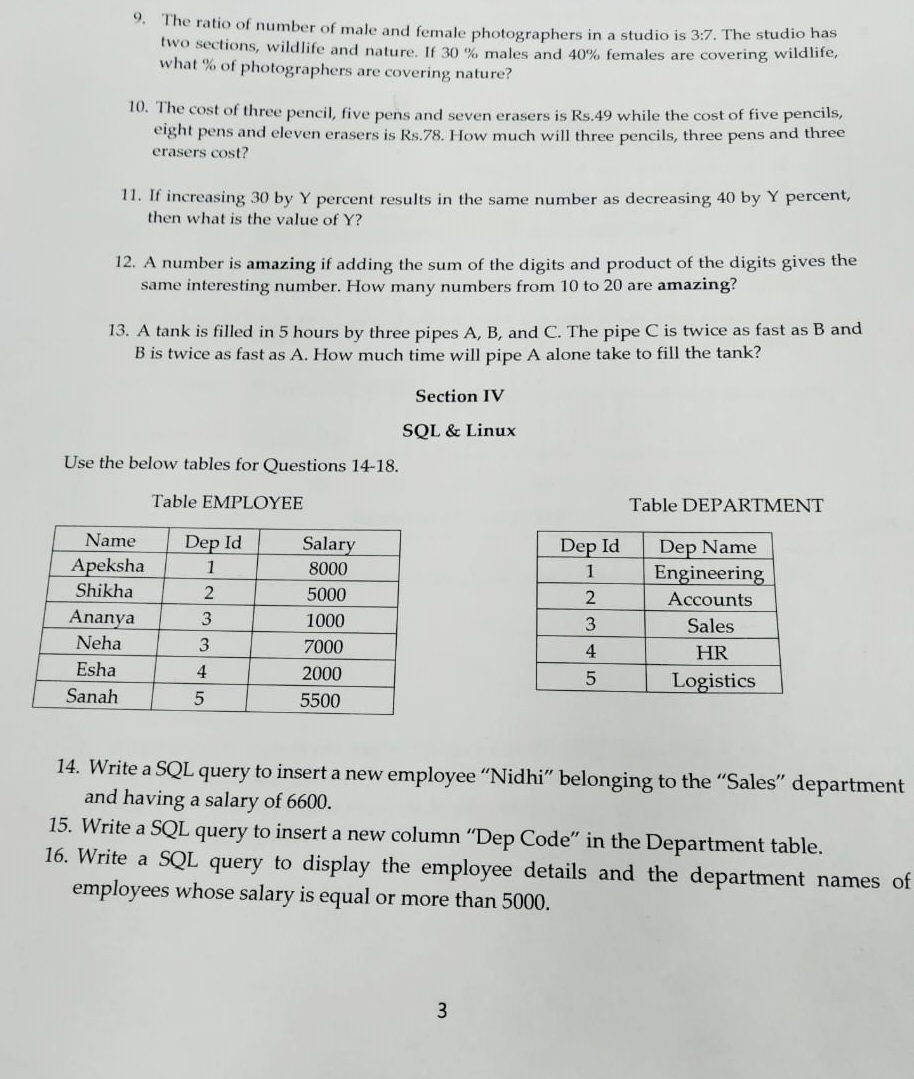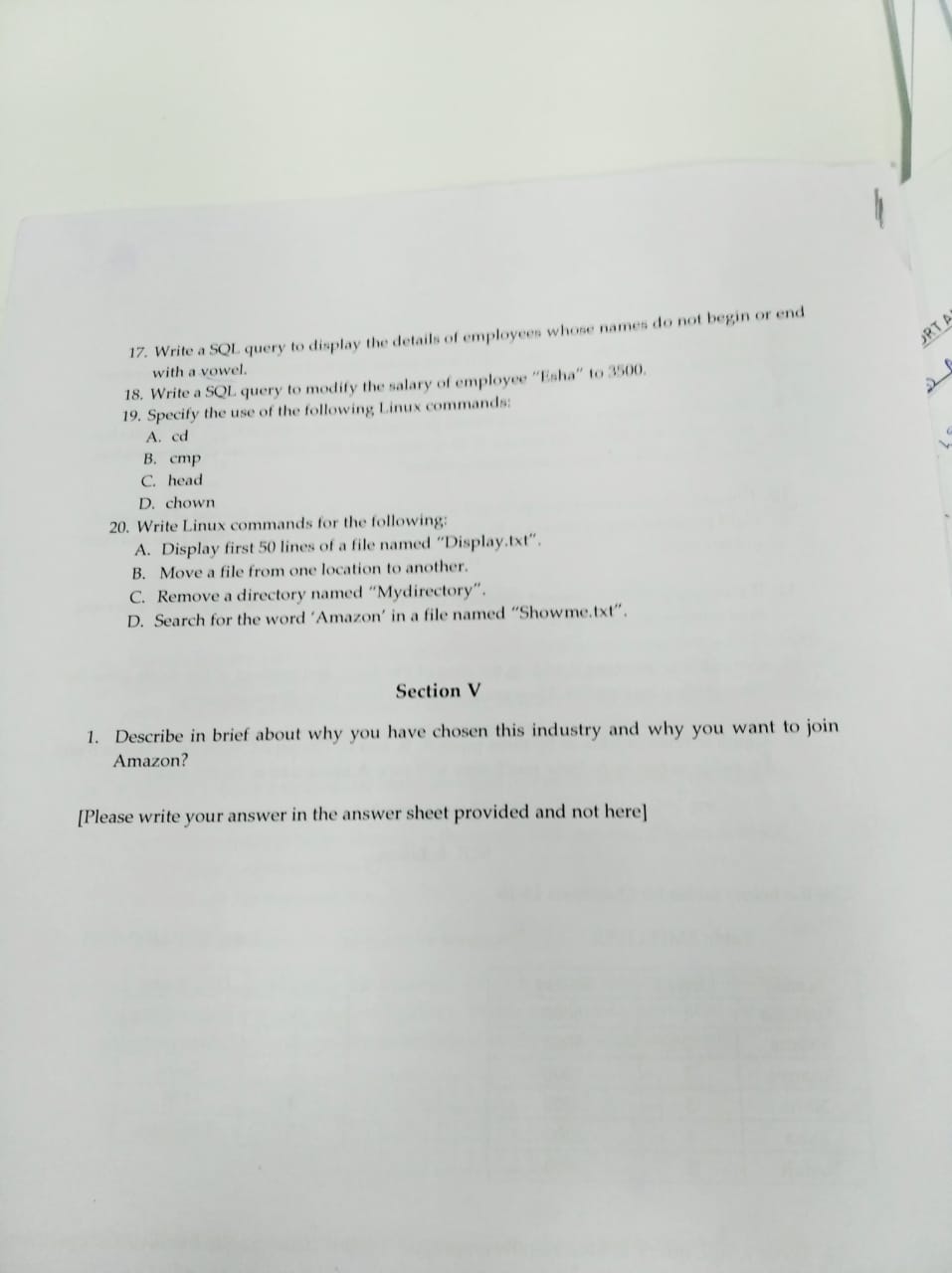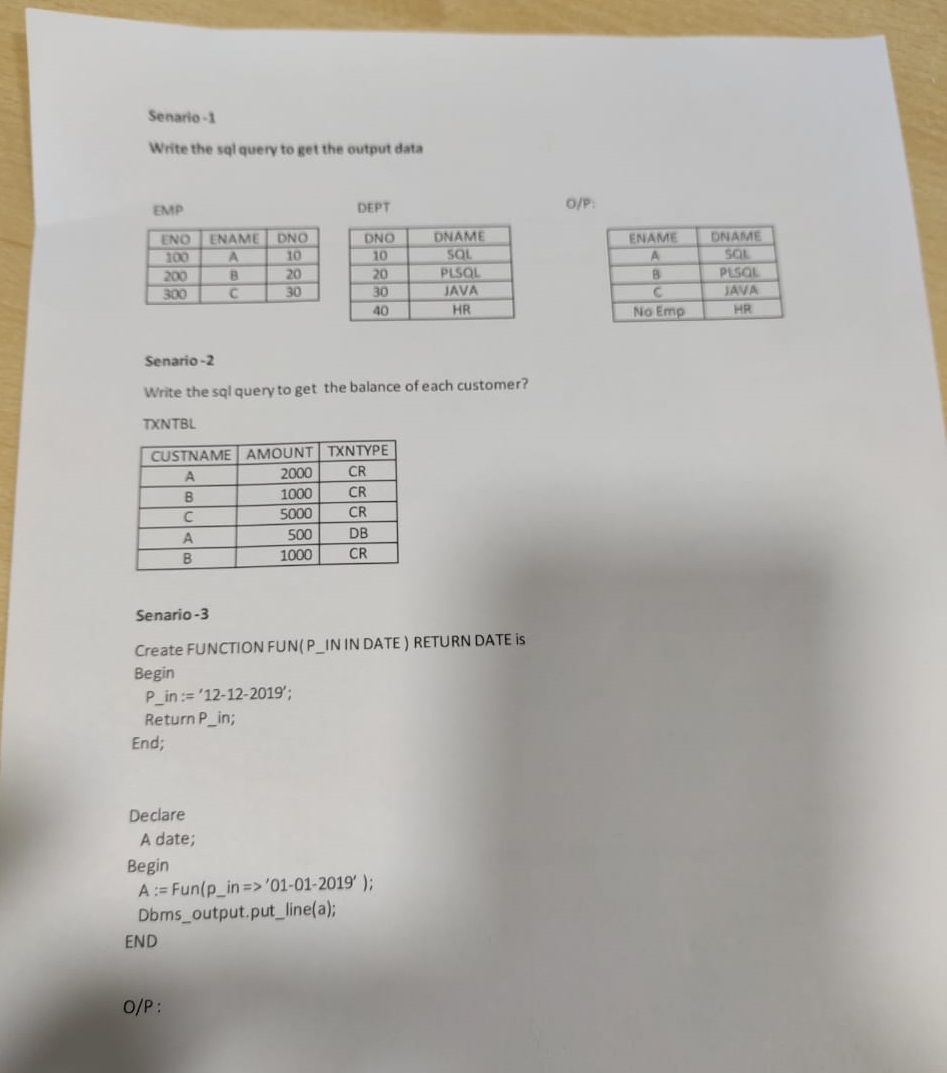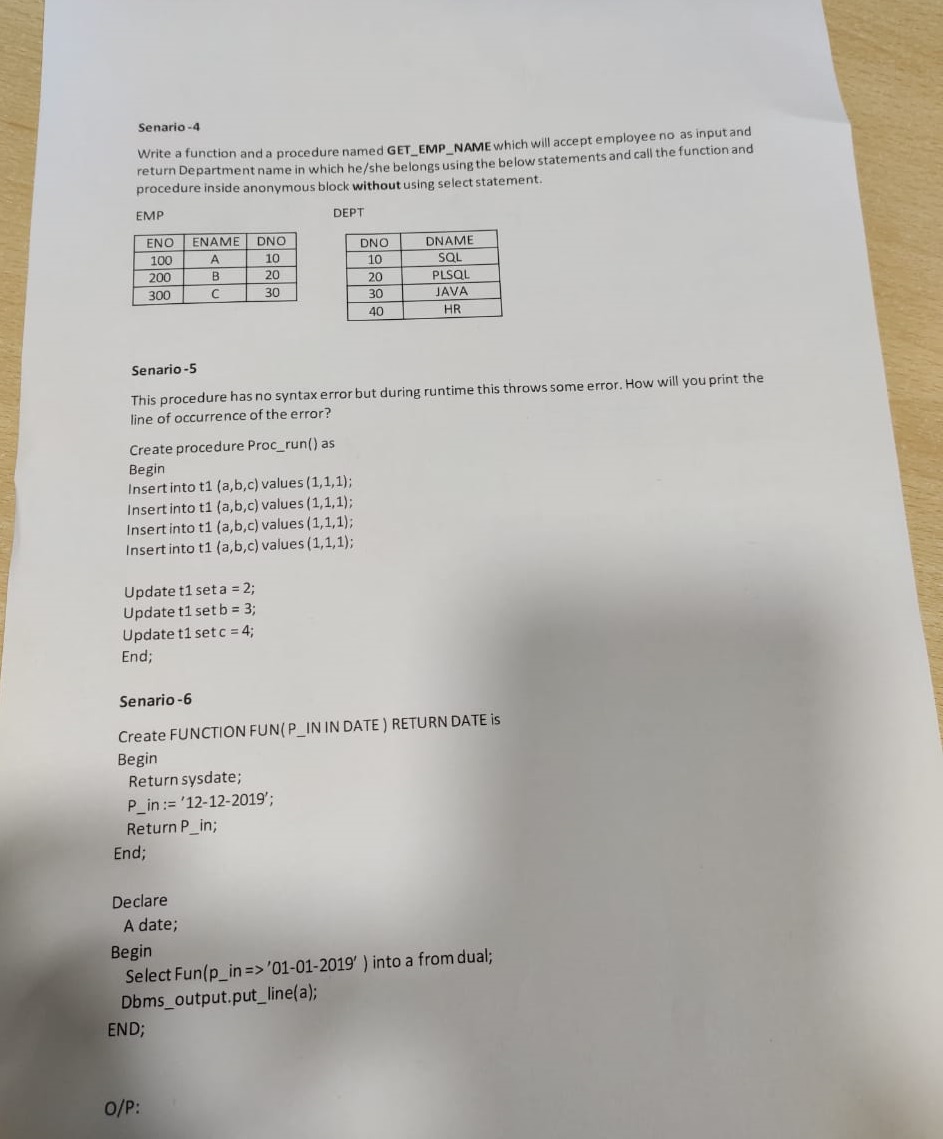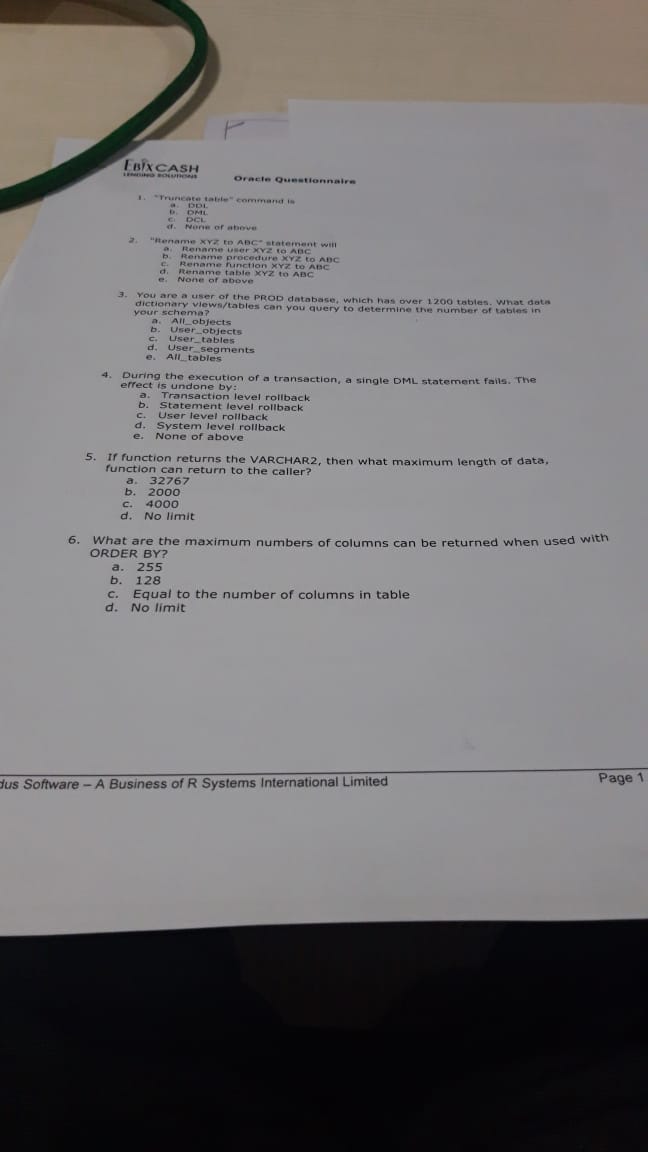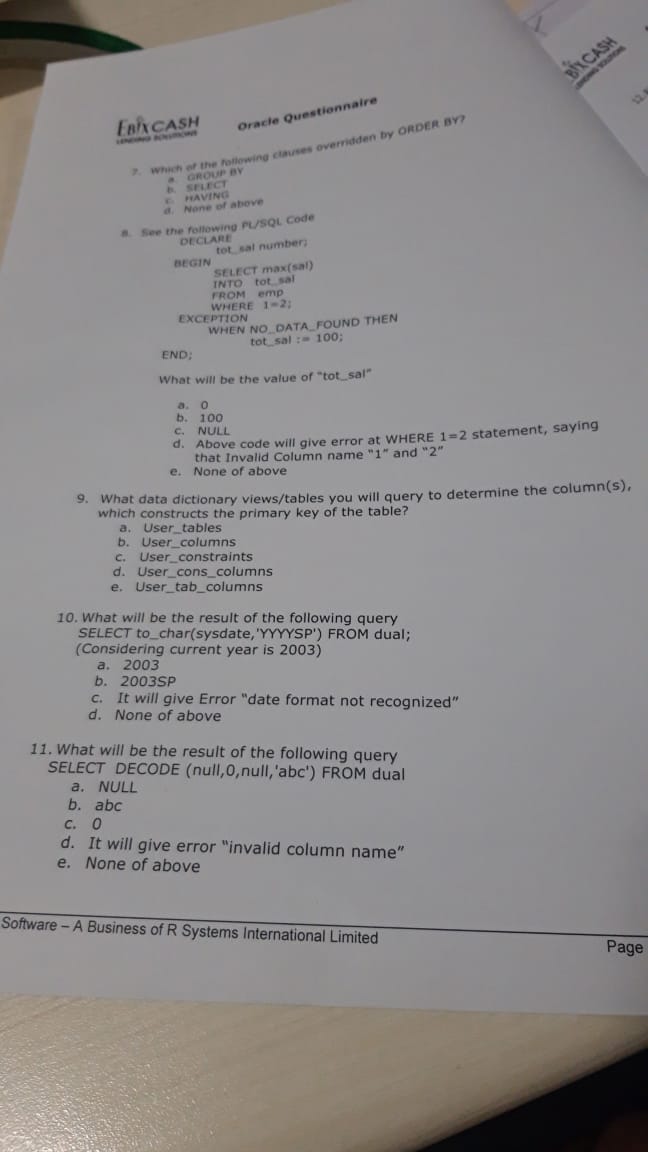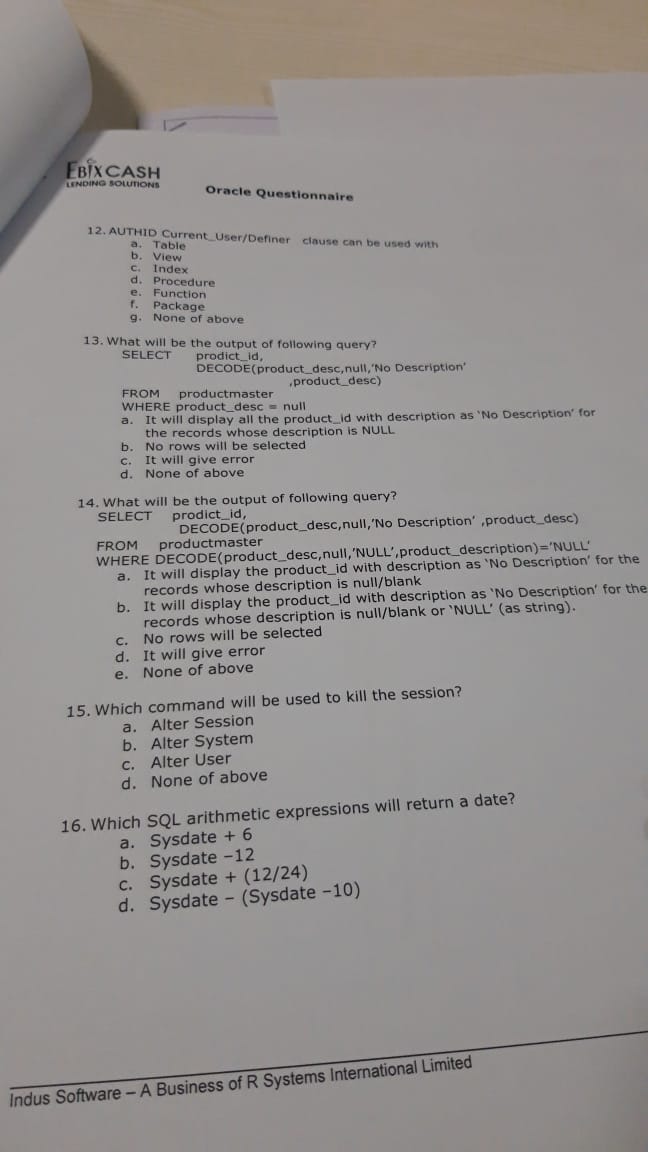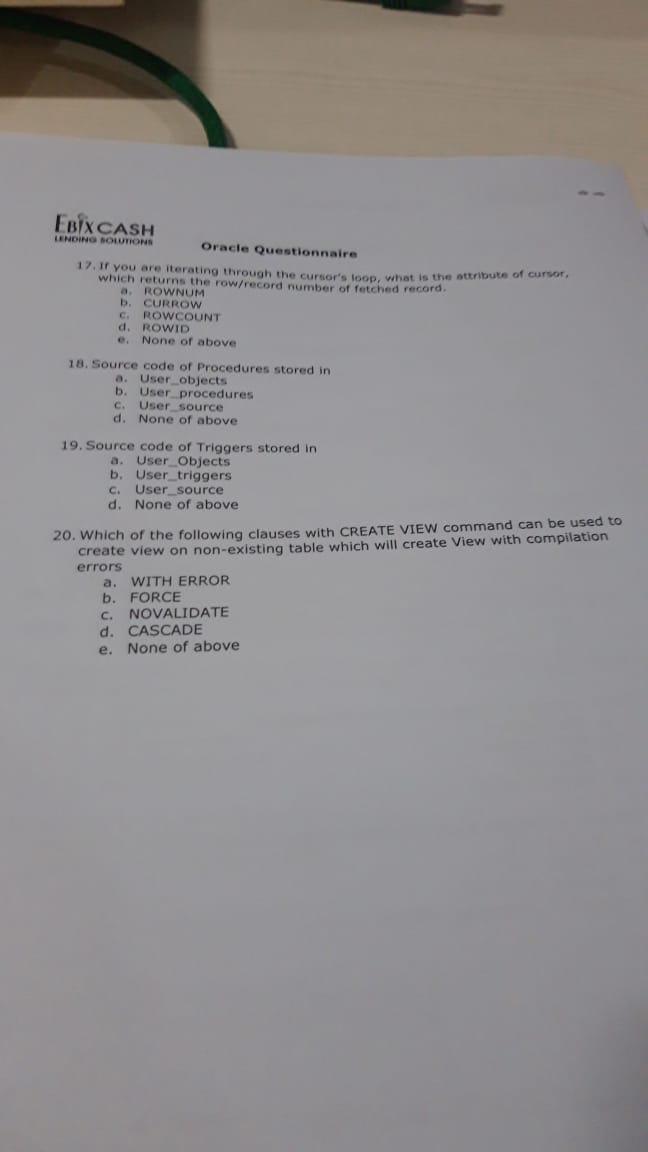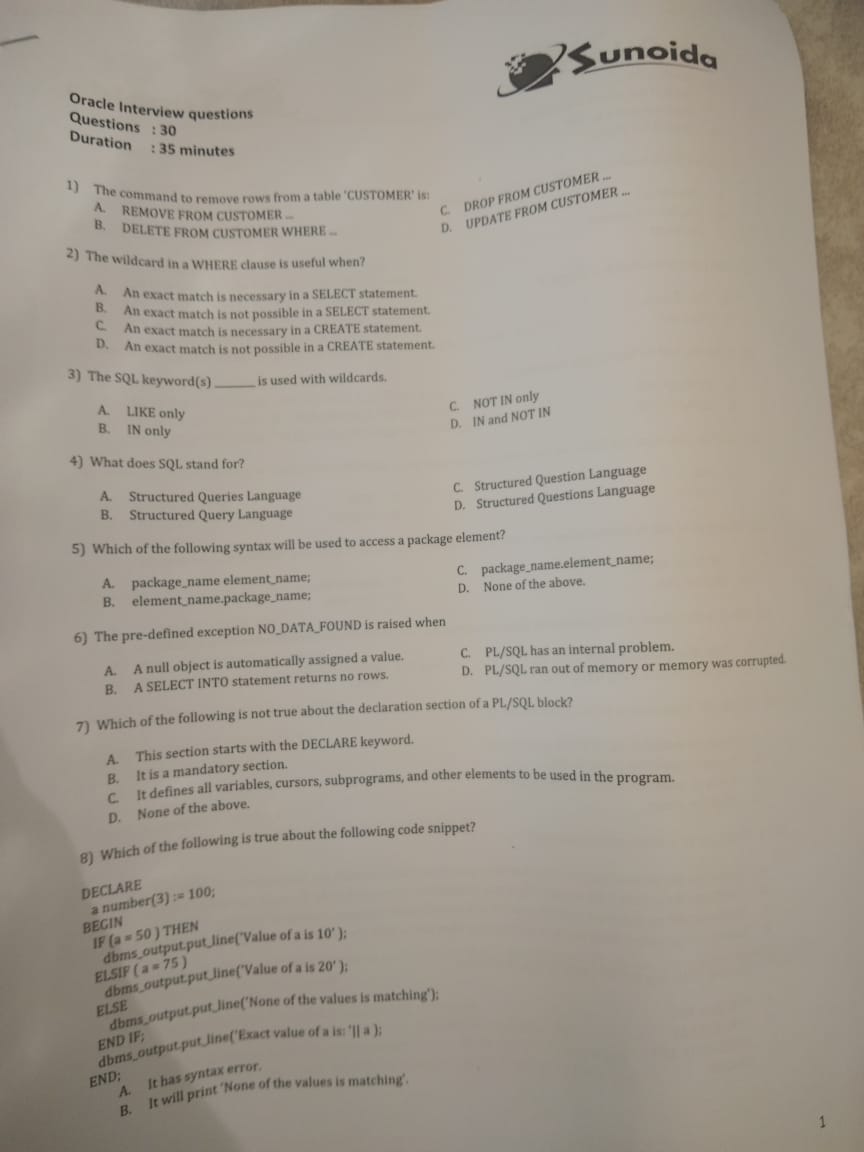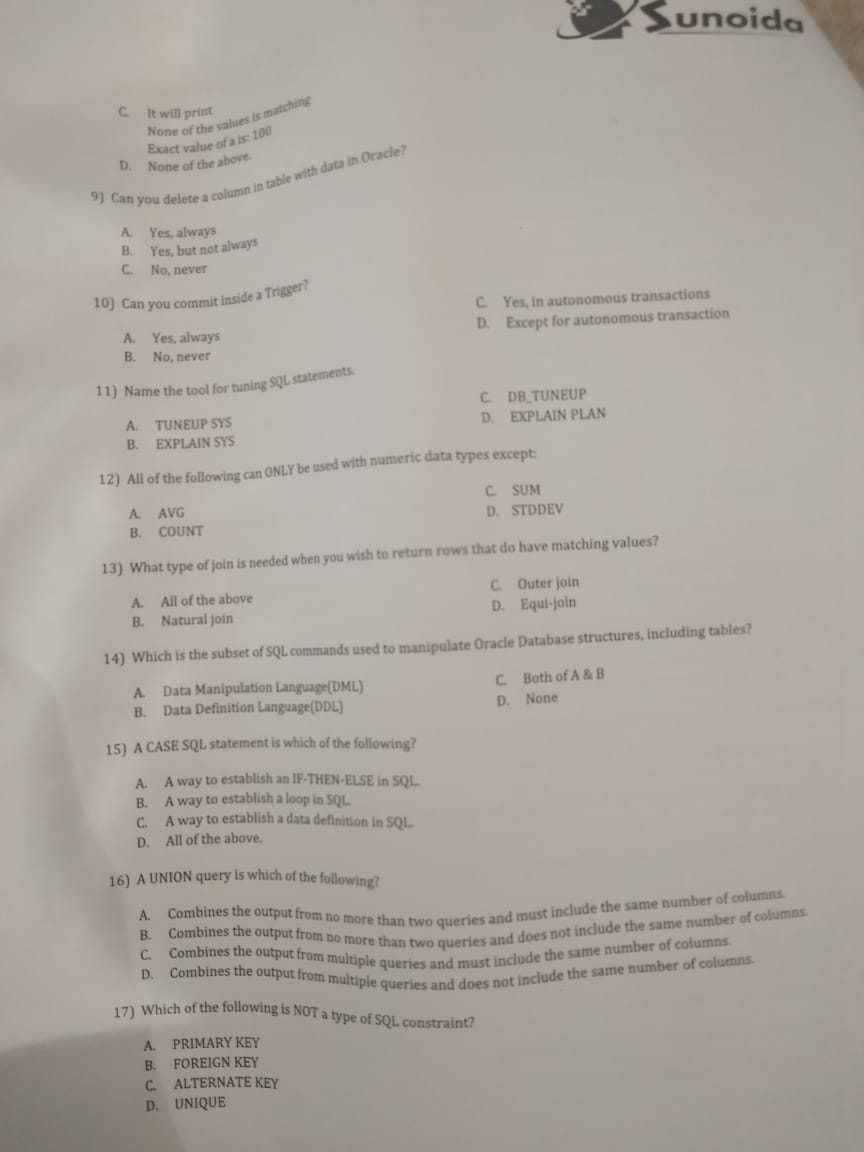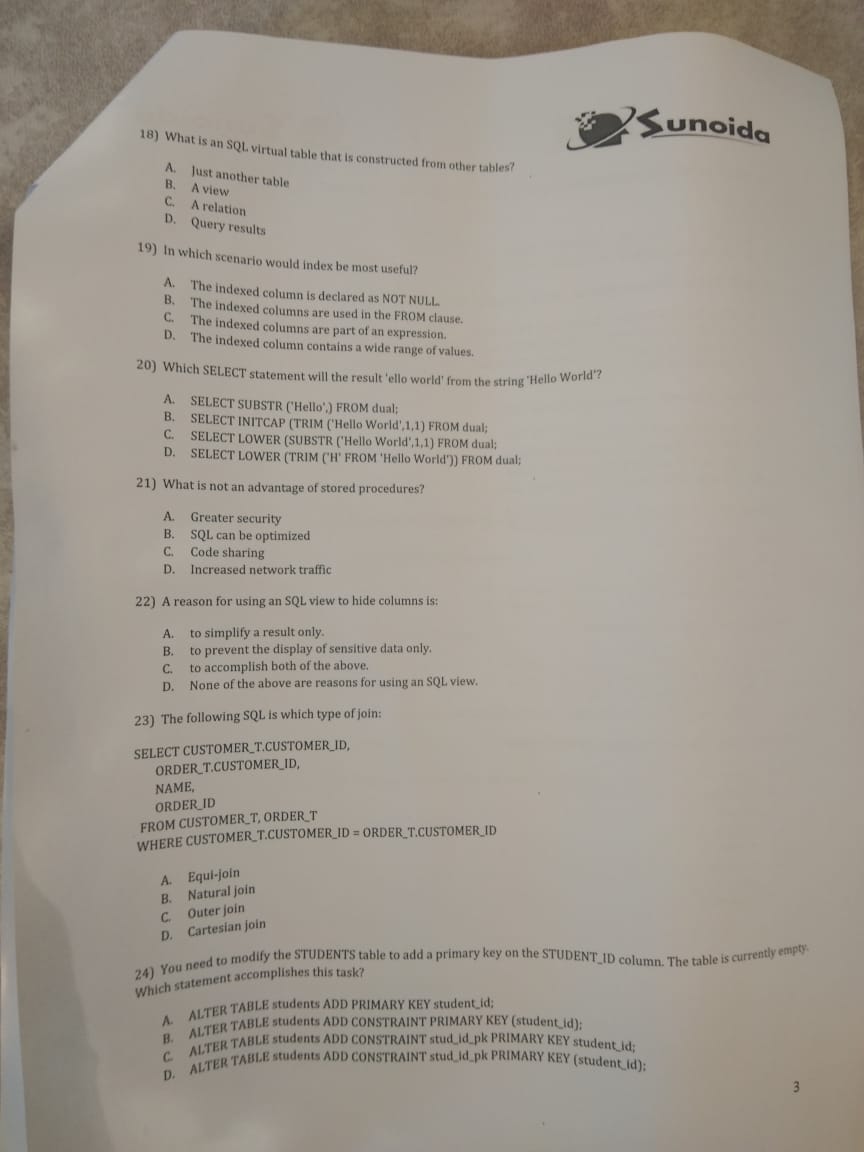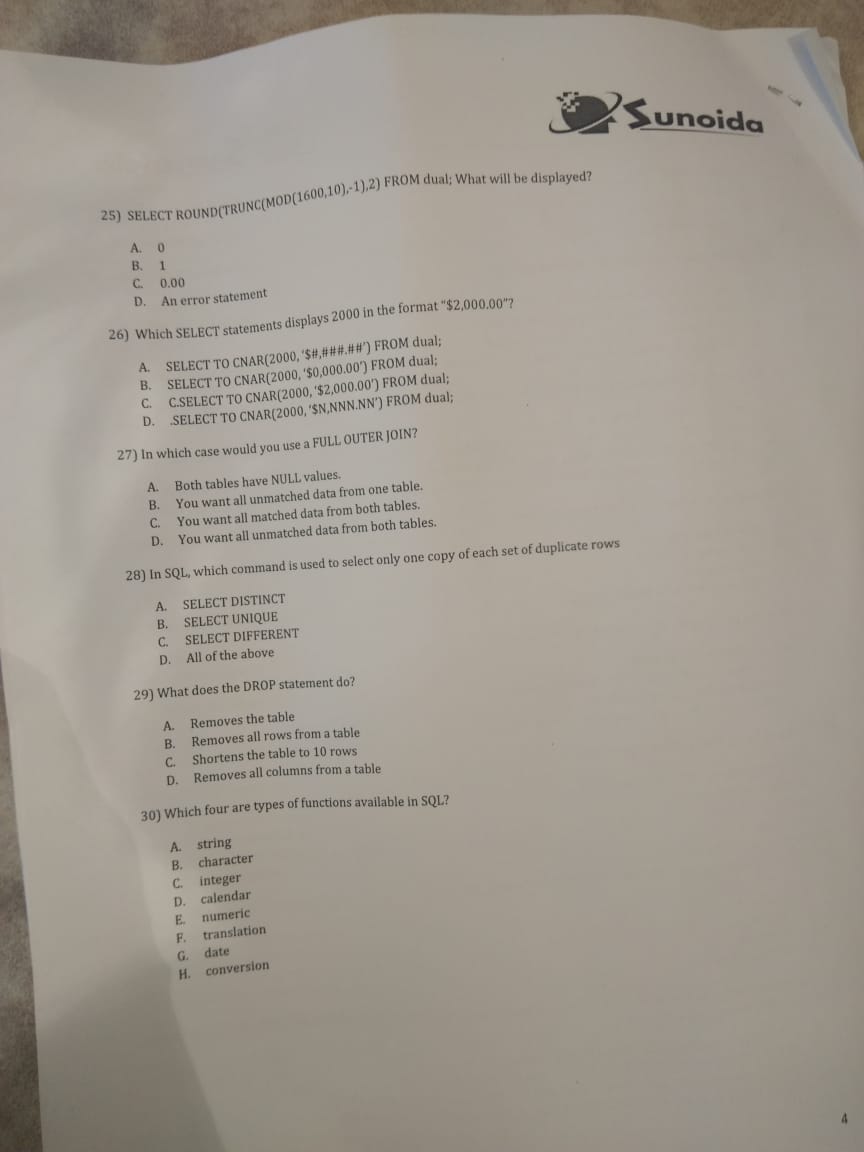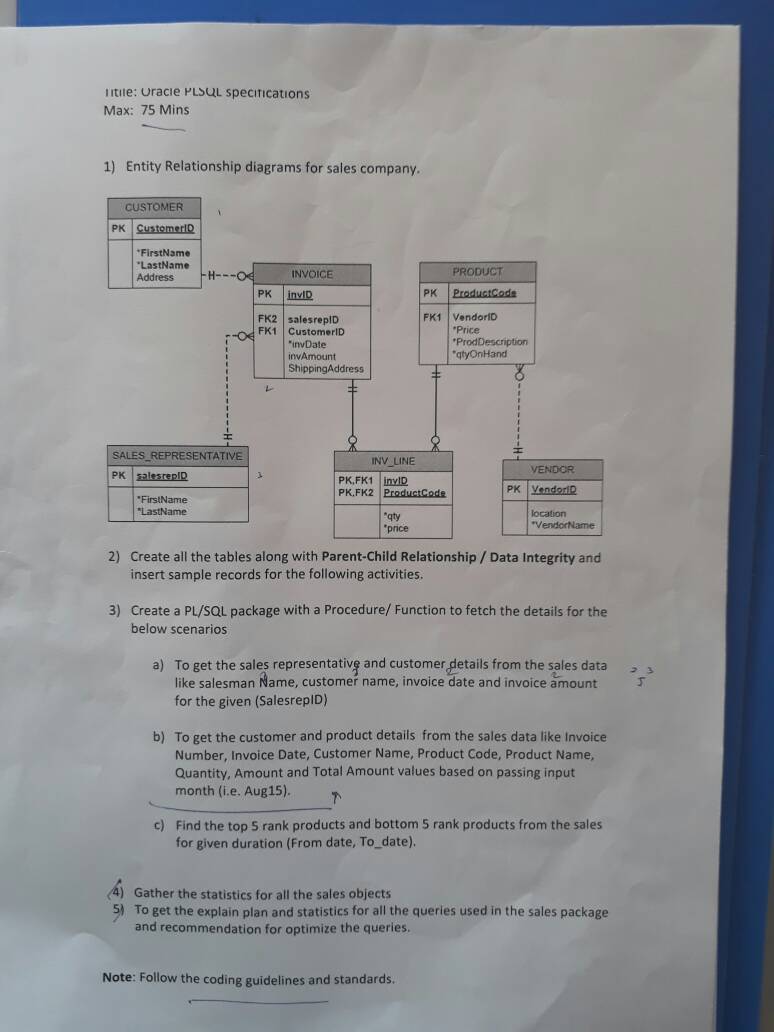Day 1
Oracle Training in Chennai
Awarded as the Best Oracle Training Center in Chennai - We Guarantee Your Oracle Training Success in Chennai
Rated as No 1 Oracle training institute in Chennai for certification and Assured Placements. Our Job Oriented Oracle training in chennai courses are taught by experienced certified professionals with extensive real-world experience. All our Best Oracle training in Chennai focuses on practical than theory model.
- Dinesh work as an Oracle Consultant & Instructor, He has over 15+ years of Oracle Implementation experience and recognized expert in Oracle SQL and PLSQL technologies, advanced analytics and Oracle data mining.
Mr. Dinesh specializes in Oracle Discoverer, Oracle OLAP and Oracle Data Warehouse Builder.
- He is also been as Senior Instructor of Oracle University and provided 200+ Corporate trainings, trained 25000+ freshers and corporate & fresher professionals.
He is an Oracle Certified Master (OCM). Expertised with RAC, Data Guard, ASM, Oracle Exadata, RMAN, Oracle Performance Tuning, Streams, Security & more.
He is among few of the Oracle Certified Master (OCM's) in the World to achieve below certifications in his area of research.
- Oracle Certified Professional (OCP) 9i
- Oracle Certified Professional (OCP) 10g
- Oracle Certified Professional (OCP) 11g
- Oracle 10g Certified RAC Expert
- Oracle 10g Certified Master (OCM)
- Oracle 11g Exadata Certified Implementation Specialist
Conducting regularly online- training for US peoples in all time zones (PST,CST,EST,HST,MST) My training is 100% Money Back Guarantee (Tuition fee) for Passing Online Examination with cent percent and ready to go live with production system immediately. If my training does not satisfy you at any point of time, even during the training period, you need not pay the tuition fee.
100% practical training only. It is not a slide show training program / theory class program. At the end of this class, definitely you will refer your colleagues / friends / relatives for my training.
Talk to the Trainer @ +91-9080125737
FREE Demo Session:
Try two FREE CLASS to see for yourself the quality of training.
Free Materials Povided during Demo sessions
Greens Technology Oracle Trainers:
Worked earlier in Oracle Corporation, IBM, Google, Verizon, CSC, Tech Mahindra, Infosys etc.
We provide hands-on Oracle training experience for the latest Oracle 11g and 12c release in Linux environment. Excellent Oracle 10g training, Oracle 11g training, and Oracle 12c training syllabus for developers and administrators.
Oracle Training Course Content
ORACLE Expert Training: Learn Oracle from the same team involved in Oracle product development.
We are the Leading Oracle real time training institute in Chennai. We offer best oracle training
with real-time project scenarios. We can guarantee classes that makes you as a Oracle Certified Professional.
Oracle Certification Training in Chennai
Best OCA / OCP Training in Chennai with in-depth Oracle Exam preparation towards Oracle 10g, Oracle 11g, Oracle 12c Certification.
Oracle Developer Certification Training
- 1Z0-061 Oracle Database 12c: SQL Fundamentals
- 1Z0-047 Oracle Database SQL Expert
- 1Z0-117 Oracle Database 11g Release 2: SQL Tuning
- 1Z0-051 Oracle Database 11g: SQL Fundamentals I
- 1Z0-147 Program with PL/SQL
- 1Z0-144 Oracle Database 11g: Program with PL/SQL
Oracle Database Administrators Certification Training
- 1Z0-062 Oracle Database 12c: Installation and Administration
- 1Z0-063 Oracle Database 12c: Advanced Administration
- 1Z0-051 Oracle Database 11g: SQL Fundamentals I
- 1Z0-052 Oracle Database 11g: Administration I
- 1Z0-053 Oracle Database 11g: Administration II
Oracle Database 10g: Real Application Clusters (RAC) Administrator Certified Expert Training
- 1Z0-048 Oracle Database 10g R2: Real Application Clusters for Administrators
All Training Sessions are Completely Practical. Theory Material provided in Advance!!
We offer Oracle job assistance (subject to project availability and partner requirements) for positions in India, Singapore, Dubai and the UK.
Oracle SQL Training Course Content :
Introduction
- Describe the features of Oracle Database 12c
- Describe the salient features of Oracle Cloud 12c
- Explain the theoretical and physical aspects of a relational database
- Describe Oracle servers implementation of RDBMS and object relational database management system (ORDBMS)
1. Basic DATABASE Concept and SQL
- Basic history of database concept: DBMS, RDBMS, ORDBMS
- Advantage of ORACLE database and version information
- Interface tools usage: sqlplus, isqlplus, sqldeveloper, Toad
- SQL Language overview : DQL, DML, DDL, DCL, TCL
- What is the usage of ANSI standard.
- SELECT Command - Column Alias Rules, String data,
- Concatenations with various data
- Null Value handling with number and characters,
- Arithmetic Operator
- Concatenation Operator,
- Eliminating Duplicate Rows
2. Restricting and Sorting Data
- WHERE Clause - Character Strings and Dates, number
- General Comparison Conditions = > >= < <= <>
- Other Comparison BETWEEN , IN , LIKE , NULL
- Logical Conditions AND OR NOT
- ORDER BY Clause, Sorting by Column Alias , Column Position, Multiple Columns
3. Single-Row Functions
- Character Functions: UPPER, LOWER, INITCAP, LENGTH, SUBSTR, INSTR, LPAD, RPAD, CONCAT, LTRIM, RTRIM, TRIM, REPLACE, TRANSLATE, REVERSE
- Number Functions: ROUND, TRUNC, MOD, POWER, CEIL , FLOOR, ABS
- Dates Functions: SYSDATE, MONTHS_BETWEEN, NEXT_DAY, LAST_DAY, ADD_MONTHS, ROUND, TRUNC, Arithmetic on Date
- Conversion Functions: Implicit Data-Type Conversion & Explicit Data-Type Conversion, TO_CHAR ,TO_NUMBER ,TO_DATE
- General Functions: NVL , NVL2 , NULLIF, COALESCE
- CASE Expression, DECODE
- Nested function with real-time usage
4. JOINS
- EQUI JOIN / SIMPLE JOIN / NORMAL JOIN
- ANSI JOIN, LEFT OUTER, RIGHT OUTER, FULL OUTER
- NATURAL JOIN, NATURAL OUTER JOINS
- INNER JOIN, JOIN ... USING clause, JOIN ... ON clause,
- CROSS JOIN, NON-EQUI JOIN, SELF JOIN
- ORACLE STANDARD OUTER JOINS.
- Multi table Joins, Complex Joins How to simplified complex joins.
5. Multi-row Functions
- Group Functions Rules, SUM, MIN, MAX, COUNT, AVG
- Creating Groups of Data: GROUP BY Clause
- Filtering Group Results: The HAVING Clause
6. Sub-queries
- Single-Row Subqueries- Rules, Operators : = > >= < <= <>
- Null Values in a Subquery
- Multi-Row Subqueries- Rules, Operators : IN, ANY , ALL
7. Reporting data using interface commands
- pagesize, linesize , column heading , column format , colsep
- tTitle , bTitle , break on column, spool , CSV file generation, Text file generation
8. Data Manipulation Language DML and Transaction Control Language TCL
- DML : INSERT, UPDATE, DELETE, MERGE
- TCL : COMMIT, ROLLBACK, SAVEPOINT
9. Data Definition Language - DDL
- DDL : CREATE, ALTER, RENAME, DROP, TRUNCATE
- DEFAULT OPTION.
- Constrain table copy
10. Constraints
- NOT NULL, UNIQUE, PRIMARY KEY, FOREIGN KEY, CHECK
- Column Level Constraint, Table Level Constraint Naming constraints and usage
- Adding a Constraint, Dropping a Constraint,
- Disabling Constraints, Enabling Constraints
- Validating Constraints
11. Views
- Simple Views and Complex Views , Create, Drop, Source Code
- Rules for Performing DML Operations on a View
- WITH CHECK OPTION , WITH READ ONLY
- Inline Views
- Materialized View , Create, Refresh, Drop - Usage
12. Other Database Objects
- Sequence- NEXTVAL and CURRVAL
- Index - When to Create an Index, When Not to Create an Index.
- Synonyms
13. DCL COMMANDS
- Creating Users
- Granting / Revoking Privileges
- Creating and Granting Privileges to a Role
14. Dictionary Tables
- Tables, Views, Synonyms, Index, Sequence, Constrains, Source and other Dictionary
15. SET Operators
- UNION ,
- UNION ALL ,
- INTERSECT ,
- MINUS
16. Advanced Date-time Functions
- TIME ZONES ,
- SYSDATE, SYSTIMESTAMP,
- CURRENT_DATE , CURRENT_TIMESTAMP
- SESSIONTIMEZONE ,
- Storing time zone data in Table
- EXTRACT ,
- TO_YMINTERVAL
17. Advanced GROUP BY Clause
- Group by with ROLLUP,
- Group by with CUBE,
- GROUPING SETS
18. Advanced Subqueries
- Pairwise Comparison Subquery ,
- Nonpairwise Comparison Subquery
- Correlated Subqueries,
- Correlated UPDATE,
- Correlated DELETE
- EXISTS , NOT EXISTS Operator
19. Hierarchical Retrieval
- Walking the Tree: From the Bottom Up , From the Top Down
- LEVEL Pseudo column,
- Connect by prior,
20. Multi-table Insert
- Unconditional INSERT ALL
- Conditional INSERT ALL
- Conditional FIRST INSERT
21. DATA LOADER
- SQLLDR Loading CSV file / Flat file into ORACLE table.
22. Analytic Functions
- WM_CONCAT, LAG, LEAD, RANK, DENSE_RANK
- Query_by partition_clause with sum, min, max, avg, count,
- order_by_clause with sum, min, max, avg, count,
- Psudo column : Rownum, Rowid, - Elimination duplicate data
- Connect by rownum , Connect by Level Generating random numbers, random dates,
- Quote Operator syntax and usage
23. Backup
- Export / Import SCHEMA
24. General discussion
- What is migration?
- Migration Estimating, Planning, Preparation Simple Scenario / Complex Scenario.
SQL and PL/SQL Certification
Become an Oracle Database SQL Certified Associate and demonstrate understanding of fundamental SQL concepts needed to undertake any database project.
Complete Oracle Database SQL 1Z0-071 and Oracle Database 11g: Program with PL/SQL 1Z0-144
to earn the Oracle Database SQL Certified Associate Certification and Oracle PL/SQL Developer Certified Associate Certification.
Oracle SQL Statement Tuning Training Course Content
Exploring the Oracle Database Architecture
- Describe the major architectural components of Oracle Database server
- Explain memory structures
- Describe background processes
- Correlate logical and physical storage structures
Introduction to SQL Tuning
- Describe what attributes of a SQL statement can make it perform poorly
- Describe the Oracle tools that can be used to tune SQL
- Explain the tuning tasks
Introduction to the Optimizer
- Describe the execution steps of a SQL statement
- Explain the need for an optimizer
- Explain the various phases of optimization
- Control the behavior of the optimizer
Interpreting Execution Plans
- Gather execution plans
- Display execution plans, display xplan
- Interpret execution plans
Application Tracing
- Configure the SQL Trace facility to collect session statistics
- Use the trcsess utility to consolidate SQL trace files
- Format trace files using the tkprof utility
- Interpret the output of the tkprof command
Optimizer Operations
- Describe the SQL operations for tables and indexes
- Describe the possible access paths for tables and indexes
Optimizer: Join Operations
- Describe the SQL operations for joins
- Describe the possible access paths for joins
Other Optimizer Operations
- Describe Clusters, In-List, Sorts, Filters and Set Operations
- Use Result Cache operations
Case Study: Star Transformation
- Define a star schema, a star query plan without transformation and a star query plan after transformation
Optimizer Statistics
- Gather optimizer statistics
- Gather system statistics
- Set statistic preferences
- Use dynamic sampling
- Manipulate optimizer statistics
Using Bind Variables
- Explain the benefits of using bind variables
- Use bind peeking
- Use adaptive cursor sharing
SQL Tuning Advisor
- Describe statement profiling
- Use SQL Tuning Advisor
Using SQL Access Advisor
- Use SQL Access Advisor
Automating SQL Tuning
- Use Automatic SQL Tuning
SQL Plan Management
- Manage SQL performance through changes
- Set up SQL Plan Management
- Set up various SQL Plan Management scenarios
Using Optimizer Hints
- Use hints when appropriate
- Specify hints for Optimizer mode, Query transformation, Access path, Join orders, Join methods and Views
Parallel Queries
Parallel Processing Concepts
- Explain what parallel processing is and why is it useful
Basics of Parallel Execution
- Describe operations that can be parallelized
- Explain parallel execution theory
- Understand impact of initiali zation parameter on parallel execution
Manual DOP Management
- Understand an explain plan of a parallel query
- Understand an explain plan of parallel DML and DDL
Simplified Auto DOP
- Understand the new parameters of Auto DOP
- Explain when to use Auto DOP
- Use Auto DOP
Statement Queuing
- Explain statement queuing, concurrency and DBRM
In-Memory Parallel execution
- Use in-memory parallel execution
Data Warehouse Administration
Partitioning Concepts
- Explain the available partitioning strategies
- Explain partition pruning
- Implement partition enhancements in star query optimization
Materialized Views
- Use summaries to improve performance
- Differentiate materialized view types
Oracle PlSQL Training Training Course Content
Introduction
- Course Objectives
- Course Agenda
- Human Resources (HR) Schema
- Introduction to SQL Developer
Introduction to PL/SQL
- PL/SQL Overview
- Benefits of PL/SQL Subprograms
- Overview of the Types of PL/SQL blocks
- Create a Simple Anonymous Block
- Generate Output from a PL/SQL Block
PL/SQL Identifiers
- List the different Types of Identifiers in a PL/SQL subprogram
- Usage of the Declarative Section to define Identifiers
- Use variables to store data
- Identify Scalar Data Types
- The %TYPE Attribute
- What are Bind Variables?
- Sequences in PL/SQL Expressions
Write Executable Statements
- Describe Basic PL/SQL Block Syntax Guidelines
- Comment Code
- Deployment of SQL Functions in PL/SQL
- How to convert Data Types?
- Nested Blocks
- Identify the Operators in PL/SQL
Interaction with the Oracle Server
- Invoke SELECT Statements in PL/SQL to Retrieve data
- Data Manipulation in the Server Using PL/SQL
- SQL Cursor concept
- Usage of SQL Cursor Attributes to Obtain Feedback on DML
- Save and Discard Transactions
Control Structures
- Conditional processing Using IF Statements
- Conditional processing Using CASE Statements
- Use simple Loop Statement
- Use While Loop Statement
- Use For Loop Statement
- Describe the Continue Statement
Composite Data Types
- Use PL/SQL Records
- The %ROWTYPE Attribute
- Insert and Update with PL/SQL Records
- Associative Arrays (INDEX BY Tables)
- Examine INDEX BY Table Methods
- Use INDEX BY Table of Records
Explicit Cursors
- What are Explicit Cursors?
- Declare the Cursor
- Open the Cursor
- Fetch data from the Cursor
- Close the Cursor
- Cursor FOR loop
- Explicit Cursor Attributes
- FOR UPDATE Clause and WHERE CURRENT Clause
Exception Handling
- Understand Exceptions
- Handle Exceptions with PL/SQL
- Trap Predefined Oracle Server Errors
- Trap Non-Predefined Oracle Server Errors
- Trap User-Defined Exceptions
- Propagate Exceptions
- RAISE_APPLICATION_ERROR Procedure
Stored Procedures and Functions
- Understand Stored Procedures and Functions
- Differentiate between anonymous blocks and subprograms
- Create a Simple Procedure
- Create a Simple Procedure with IN parameter
- Create a Simple Function
- Execute a Simple Procedure
- Execute a Simple Function
Create Stored Procedures
- Create a Modularized and Layered Subprogram Design
- Modularize Development With PL/SQL Blocks
- Describe the PL/SQL Execution Environment
- Identity the benefits of Using PL/SQL Subprograms
- List the differences Between Anonymous Blocks and Subprograms
- Create, Call, and Remove Stored Procedures Using the CREATE Command and SQL Developer
- Implement Procedures Parameters and Parameters Modes
- View Procedures Information Using the Data Dictionary Views and SQL Developer
Create Stored Functions
- Create, Call, and Remove a Stored Function Using the CREATE Command and SQL Developer
- Identity the advantages of Using Stored Functions in SQL Statements
- List the steps to create a stored function
- Implement User-Defined Functions in SQL Statements
- Identity the restrictions when calling Functions from SQL statements
- Control Side Effects when calling Functions from SQL Expressions
- View Functions Information
Create Packages
- Identity the advantages of Packages
- Describe Packages
- List the components of a Package
- Develop a Package
- How to enable visibility of a Packages components?
- Create the Package Specification and Body Using the SQL CREATE Statement and SQL Developer
- Invoke Package Constructs
- View PL/SQL Source Code Using the Data Dictionary
Packages
- Overloading Subprograms in PL/SQL
- Use the STANDARD Package
- Use Forward Declarations to Solve Illegal Procedure Reference
- Implement Package Functions in SQL and Restrictions
- Persistent State of Packages
- Persistent State of a Package Cursor
- Control Side Effects of PL/SQL Subprograms
- Invoke PL/SQL Tables of Records in Packages
Implement Oracle-Supplied Packages in Application Development
- What are Oracle-Supplied Packages?
- Examples of Some of the Oracle-Supplied Packages
- How Does the DBMS_OUTPUT Package Work?
- Use the UTL_FILE Package to Interact With Operating System Files
- Invoke the UTL_MAIL Package
- Write UTL_MAIL Subprograms
Dynamic SQL
- The Execution Flow of SQL
- What is Dynamic SQL?
- Declare Cursor Variables
- Dynamically executing a PL/SQL Block
- Configure Native Dynamic SQL to Compile PL/SQL Code
- Invoke DBMS_SQL Package
- Implement DBMS_SQL with a Parameterized DML Statement
- Dynamic SQL Functional Completeness
Design Considerations for PL/SQL Code
- Standardize Constants and Exceptions
- Understand Local Subprograms
- Write Autonomous Transactions
- Implement the NOCOPY Compiler Hint
- Invoke the PARALLEL_ENABLE Hint
- The Cross-Session PL/SQL Function Result Cache
- The DETERMINISTIC Clause with Functions
- Usage of Bulk Binding to Improve Performance
Triggers
- Describe Triggers
- Identify the Trigger Event Types and Body
- Business Application Scenarios for Implementing Triggers
- Create DML Triggers Using the CREATE TRIGGER Statement and SQL Developer
- Identify the Trigger Event Types, Body, and Firing (Timing)
- Statement Level Triggers Versus Row Level Triggers
- Create Instead of and Disabled Triggers
- How to Manage, Test, and Remove Triggers?
Create Compound, DDL, and Event Database Triggers
- What are Compound Triggers?
- Identify the Timing-Point Sections of a Table Compound Trigger
- Compound Trigger Structure for Tables and Views
- Implement a Compound Trigger to Resolve the Mutating Table Error
- Compare Database Triggers to Stored Procedures
- Create Triggers on DDL Statements
- Create Database-Event and System-Event Triggers
- System Privileges Required to Manage Triggers
Oracle DBA Training Training Course Content
Exploring the Oracle Database Architecture
- Oracle Database Architecture Overview
- Oracle ASM Architecture Overview
- Process Architecture
- Memory structrues
- Logical and physical storage structures
- ASM storage components
Installing your Oracle Software
- Tasks of an Oracle Database Administrator
- Tools Used to Administer an Oracle Database
- Installation: System Requirements
- Oracle Universal Installer (OUI)
- Installing Oracle Grid Infrastructure
- Installing Oracle Database Software
- Silent Install
Creating an Oracle Database
- Planning the Database
- Using the DBCA to Create a Database
- Password Management
- Creating a Database Design Template
- Using the DBCA to Delete a Database
Managing the Oracle Database Instance
- Start and stop the Oracle database and components
- Use Oracle Enterprise Manager
- Access a database with SQLPlus
- Modify database installation parameters
- Describe the stages of database startup
- Describe database shutdown options
- View the alert log
- Access dynamic performance views
Manage the ASM Instance
- Set up initialization parameter files for ASM instance
- Start up and shut down ASM instances
- Administer ASM disk groups
Configuring the Oracle Network Environment
- Use Enterprise Manager to create and configure the Listener
- Enable Oracle Restart to monitor the listener
- Use tnsping to test Oracle Net connectivity
- Identify when to use shared servers and when to use dedicated servers
Managing Database Storage Structures
- Storage Structures
- How Table Data Is Stored
- Anatomy of a Database Block
- Space Management in Tablespaces
- Tablespaces in the Preconfigured Database
- Actions with Tablespaces
- Oracle Managed Files (OMF)
Administering User Security
- Database User Accounts
- Predefined Administrative Accounts
- Benefits of Roles
- Predefined Roles
- Implementing Profiles
Managing Data Concurrency
- Data Concurrency
- Enqueue Mechanism
- Resolving Lock Conflicts
- Deadlocks
Managing Undo Data
- Data Manipulation
- Transactions and Undo Data
- Undo Data Versus Redo Data
- Configuring Undo Retention
Implementing Oracle Database Auditing
- Describe DBA responsibilities for security
- Enable standard database auditing
- Specify audit options
- Review audit information
- Maintain the audit trail
Database Maintenance
- Manage optimizer statistics
- Manage the Automatic Workload Repository (AWR)
- Use the Automatic Database Diagnostic Monitor (ADDM)
- Describe and use the advisory framework
- Set alert thresholds
- Use server-generated alerts
- Use automated tasks
Performance Management
- Performance Monitoring
- Managing Memory Components
- Enabling Automatic Memory Management (AMM)
- Automatic Shared Memory Advisor
- Using Memory Advisors
- Dynamic Performance Statistics
- Troubleshooting and Tuning Views
- Invalid and Unusable Objects
Backup and Recovery Concepts
- Part of Your Job
- Statement Failure
- User Error
- Understanding Instance Recovery
- Phases of Instance Recovery
- Using the MTTR Advisor
- Media Failure
- Archive Log Files
Performing Database Backups
- Backup Solutions: Overview
- Oracle Secure Backup
- User-Managed Backup
- Terminology
- Recovery Manager (RMAN)
- Configuring Backup Settings
- Backing Up the Control File to a Trace File
- Monitoring the Flash Recovery Area
Performing Database Recovery
- Opening a Database
- Data Recovery Advisor
- Loss of a Control File
- Loss of a Redo Log File
- Data Recovery Advisor
- Data Failures
- Listing Data Failures
- Data Recovery Advisor Views
Moving Data
- Describe ways to move data
- Create and use directory objects
- Use SQL*Loader to move data
- Use external tables to move data
- General architecture of Oracle Data Pump
- Use Data Pump export and import to move data
Working with Support
- Use the Enterprise Manager Support Workbench
- Work with Oracle Support
- Log service requests (SR)
- Manage patches
Core Concepts and Tools of the Oracle Database
- The Oracle Database Architecture: Overview
- ASM Storage Concepts
- Connecting to the Database and the ASM Instance
- DBA Tools Overview
Configuring for Recoverability
- Purpose of Backup and Recovery (B&R), Typical Tasks and Terminology
- Using the Recovery Manager (RMAN)
- Configuring your Database for B&R Operations
- Configuring Archivelog Mode
- Configuring Backup Retention
- Configuring and Using a Flash Recovery Area (FRA)
Using the RMAN Recovery Catalog
- Tracking and Storing Backup Information
- Setting up a Recovery Catalog
- Recording Backups
- Using RMAN Stored Scripts
- Managing the Recovery Catalog (Backup, Export, Import, Upgrade, Drop and Virtual Private Catalog)
Configuring Backup Settings
- Configuring and Managing Persistent Settings for RMAN
- Configuring Autobackup of Control File
- Backup optimization
- Advanced Configuration Settings: Compressing Backups
- Configuring Backup and Restore for Very Large Files (Multisection)
Creating Backups with RMAN
- RMAN backup types
- Creating and Using the following:
- - Backup Sets and Image Copies
- - Whole Database Backup
- - Fast Incremental Backup
- - Configure Backup Destinations
- - Duplexed Backup Sets
- - Archival Backups
Restore and Recovery Task
- Restoring and Recovering
- Causes of File Loss
- Automatic Tempfile Recovery
- Recovering from the Loss of a Redo Log Group
- Recovering from a Lost Index Tablespace
- Re-creating a Password Authentication File
- Complete and Incomplete Recovery
- Other Recovery Operations
Using RMAN to Perform Recovery
- Complete Recovery after Loss of a Critical or Noncritical Data File
- Recovering Image Copies and Switching Files
- Restore and Recovery of a Database in NOARCHIVELOG Mode
- Incomplete Recovery
- Performing Recovery with a Backup Control File
- Restoring from Autobackup: Server Parameter File and Control File
- Restoring and Recovering the Database on a New Host
Monitoring and Tuning RMAN
- Monitoring RMAN Jobs
- Balance Between Speed of Backup Versus Speed of Recovery
- RMAN Multiplexing
- Synchronous and Asynchronous I/O
- Explaining Performance Impact of MAXPIECESIZE, FILESPERSET, MAXOPENFILES and BACKUP DURATION
Diagnosing the Database
- Data Recovery Advisor (DRA)
- Block Corruption
- Automatic Diagnostic Repository (ADR)
- Health Monitor
- The ADR Command-Line Tool, ADRCI
Using Flashback Technology I
- Flashback Technology: Overview and Setup
- Using Flashback Technology to Query Data
- Flashback Table
- Flashback Transaction Query
- Performing Flashback Transaction Backout
Using Flashback Technology II
- Oracle Total Recall
- Flashback Drop and the Recycle Bin
Performing Flashback Database
- Configuring Flashback Database
- Performing Flashback Database Operations
- Monitoring Flashback Database
Managing Memory
- Oracle Memory Structures
- Oracle Database Memory Parameters
- Using Automatic Memory Management
- Automatic Shared Memory Management
- Using Memory Advisors
- Using Data Dictionary Views
Managing Database Performance
- Tuning Activities
- Using Statistic Preferences
- Optimizer Statistics Collection
- Monitor the Performance of Sessions and Services
- Automatic Workload Repository (AWR)
- Describing the Benefits of Database Replay
Managing Performance by SQL Tuning
- SQL Tuning and SQL Advisors
- Using SQL Tuning Advisor
- SQL Access Advisor
- SQL Performance Analyzer Overview
Managing Resources
- Database Resource Manager: Overview and Concepts
- Accessing and Creating Resource Plans
- Creating Consumer Group
- Specifying Resource Plan Directives, including:
- - Limiting CPU Utilization at the Database Level
- - Instance Caging
- Activating a Resource Plan
- Monitoring the Resource Manager
Automating Tasks with the Scheduler
- Simplifying Management Tasks
- Creating a Job, Program, and Schedule
- Using Time-Based, Event-Based, and Complex Schedules
- Describing the Use of Windows, Window Groups, Job Classes, and Consumer Groups
- Multi-Destination Jobs
Managing Space in Blocks
- Free Space Management
- Monitoring Space
- Compressing Data
Managing Space in Segments
- Segment Creation on Demand
- Additional Automatic Space-Saving Functionalit
- Shrinking Segments
- Segment Advisor
- Managing Resumable Space Allocation
Managing Space for the Database
- Using 4 KB-Sector Disks
- Transporting Tablespaces
- Transporting Databases
Duplicating a Database
- Purpose and Methods of Cloning a Database
- Using RMAN to Create a Duplicate Database
- Cloning a Database from a Backup
- Duplicate a Database Based on a Running Instance
- Targetless Duplicating a Database
Oracle DBA Performance Tuning Training in Chennai
Basic Tuning Tools
- Monitoring tools overview
- Enterprise Manager
- V$ Views, Statistics and Metrics
- Wait Events
Using Automatic Workload Repository
- Managing the Automatic Workload RepositoryCreate AWR Snapshots
- Real Time SQL Monitoring (a 11.1 feature new lesson in NF L-15)
Defining Problems
- Defining the Problem
- Limit the Scope & Setting the Priority
- Top SQL Reports
- Common Tuning Problems & Tuning During the Life Cycle
- ADDM Tuning Session
- Performance Versus Business Requirements
- Performance Tuning Resources & Filing a Performance Service Request
- Monitoring and Tuning Tools: Overview
Using Metrics and Alerts
- Metrics, Alerts, and Baselines
- Limitation of Base Statistics & Typical Delta Tools
- Oracle Database 11g Solution: Metrics
- Benefits of Metrics
- Viewing Metric History Information & Vsing EM to View Metric Details
- Statistic Histograms & Histogram Views
- Database Control Usage Model & Setting Thresholds
- Server-Generated Alerts, Creating and Testing an Alert & Metric and Alert Views
Using Baselines
- Comparative Performance Analysis with AWR Baselines
- Automatic Workload Repository Baselines
- Moving Window Baseline
- Baselines in Performance Page Settings & Baseline Templates
- AWR Baselines & Creating AWR Baselines
- Managing Baselines with PL/SQL & Baseline Views
- Performance Monitoring and Baselines & Defining Alert Thresholds Using a Static Baseline
- Using EM to Quickly Configure & Changing Adaptive Threshold Settings
Using AWR Based Tools
- Automatic Maintenance Tasks
- ADDM Performance Monitoring
- Active Session History: Overview
Monitoring an Application
- What Is a Service? Service Attributes & Service Types
- Creating Services & Managing Services in a Single-Instance Environment
- Everything Switches to Services.
- Using Services with Client Applications & Using Services with the Resource Manager
- Services and Resource Manager with EM & Using Services with the Scheduler
- Using Services with Parallel Operations & Metric Thresholds
- Service Aggregation and Tracing & Service Aggregation Configuration.
- Client Identifier Aggregation and Tracing & Service Performance Views
Identifying Problem SQL Statements
- SQL Statement Processing Phases & Role of the Oracle Optimizer
- Identifying Bad SQL, Real Time SQL Monitoring (a 11.1 feature new lesson in NF L-15) & TOP SQL Reports
- What Is an Execution Plan? Methods for Viewing Execution Plans & Uses of Execution Plans
- DBMS_XPLAN Package: Overview & EXPLAIN PLAN Command
- Reading an Execution Plan, Using the V$SQL_PLAN View & Querying the AWR
- SQL*Plus AUTOTRACE & SQL Trace Facility
- How to Use the SQL Trace Facility
- Generate an Optimizer Trace
Influencing the Optimizer
- Functions of the Query Optimizer, Selectivity, Cardinality and Cost & Changing Optimizer Behavior
- Using Hints, Optimizer Statistics & Extended Statistics
- Controlling the Behavior of the Optimizer with Parameters
- Enabling Query Optimizer Features & Influencing the Optimizer Approach
- Optimizing SQL Statements, Access Paths & Choosing an Access Path
- Join & Sort Operations
- How the Query Optimizer Chooses Execution Plans for Joins
- Reducing the Cost
Using SQL Performance Analyzer
- Real Application Testing: Overview & Use Cases
- SQL Performance Analyzer: Process & Capturing the SQL Workload
- Creating a SQL Performance Analyzer Task & SPA (NF Lesson 9) DBMS_SQLTUNE.CREATE_TUNING_TASK
- Optimizer Upgrade Simulation & SQL Performance Analyzer Task Page
- Comparison Report & Comparison Report SQL Detail
- Tuning Regressing Statements & Preventing Regressions
- Parameter Change Analysis & Guided Workflow Analysis
- SQL Performance Analyzer: PL/SQL Example & Data Dictionary Views
SQL Performance Management
- Maintaining SQL Performance and Optimizer Statistics & Automated Maintenance Tasks
- Statistic Gathering Options & Setting Statistic Preferences
- Restore Statistics
- Deferred Statistics Publishing: Overview & Example
- Automatic SQL Tuning: Overview
- SQL Tuning Advisor: Overview
- Using the SQL Access Advisor
- SQL Plan Management: Overview
Using Database Replay
- The Big Picture & System Architecture
- Capture & Replay Considerations
- Replay Options & Analysis
- Database Replay Workflow in Enterprise Manager
- Packages and Procedures
- Data Dictionary Views: Database Replay
- Database Replay: PL/SQL Example
- Calibrating Replay Clients
Tuning the Shared Pool
- Shared Pool Architecture & Operation
- The Library Cache & Latch and Mutex
- Diagnostic Tools for Tuning the Shared Pool
- Avoiding Hard & Soft Parses
- Sizing the Shared Pool & Avoiding Fragmentation
- Data Dictionary Cache & SQL Query Result Cache
- UGA and Oracle Shared Server
- Large Pool & Tuning the Large Pool
Tuning the Buffer Cache
- Oracle Database Architecture: Buffer Cache
- Database Buffers
- Buffer Hash Table for Lookups
- Working Sets
- Buffer Cache Tuning Goals and Techniques
- Buffer Cache Performance Symptoms & Solutions
- Automatically Tuned Multiblock Reads
- Flushing the Buffer Cache (for Testing Only)
Tuning PGA and Temporary Space
- SQL Memory Usage & Performance Impact
- SQL Memory Manager
- Configuring Automatic PGA Memory & Setting PGA_AGGREGATE_TARGET Initially
- Monitoring & Tuning SQL Memory Usage
- PGA Target Advice Statistics & Histograms
- Automatic PGA and Enterprise Manager & Automatic PGA and AWR Reports
- Temporary Tablespace Management: Overview & Monitoring Temporary Tablespace
- Temporary Tablespace Shrink & Tablespace Option for Creating Temporary Table
Automatic Memory Management
- Oracle Database Architecture, Dynamic SGA & Memory Advisories
- Granule & Manually Adding Granules to Components
- Increasing the Size of an SGA Component, SGA Sizing Parameters & Manually Resizing Dynamic SGA Parameters
- Automatic Shared Memory Management & Memory Broker Architecture
- Behavior of Auto-Tuned & Manually TunedSGA Parameters
- Using the V$PARAMETER View & Resizing SGA_TARGET
- Disabling, Configuring & Monitoring Automatic Shared Memory Management (ASMM)
- Automatic Memory Management
Tuning Segment Space Usage
- Space and Extent Management & Locally Managed Extents
- How Table Data Is Stored & Anatomy of a Database Block
- Minimize Block Visits
- The DB_BLOCK_SIZE Parameter
- Small & Large Block Size: Considerations
- Block Allocation, Free Lists & Block Space Management with Free Lists
- Automatic Segment Space Management
- Migration and Chaining, Shrinking Segments & Table Compression: Overview
Tuning I/O
- I/O Architecture, File System Characteristics, I/O Modes & Direct I/O
- Bandwidth Versus Size & Important I/O Metrics for Oracle Databases
- I/O Calibration and Enterprise Manager, I/O Calibration and the PL/SQL Interface & I/O Statistics and Enterprise Manager
- Stripe and Mirror Everything
- Using RAID
- I/O Diagnostics
- Database I/O Tuning
- What Is Automatic Storage Management?
Performance Tuning Summary
- Best practices identified throughout the course
- Summarize the performance tuning methodology
Using Statspack
- Installing Statspack
- Capturing Statspack Snapshots
- Reporting with Statspack
- Statspack Considerations
- Statspack and AWR Reports
- Reading a Statspack Report
- Statspack and AWR
Oracle DBA Data Guard Training Course Content
Introduction to Oracle Data Guard
- Causes of Data Loss
- Oracle Data Guard Architecture
- Types of Standby Databases (benefits of each type)
- Using the Data Guard Broker
- Differentiating Between Standby Databases and Data Guard Broker Configuration
- Data Protection Modes
- Performing Role Transitions
Creating a Physical Standby Database by Using SQL and RMAN Commands
- Preparing the Primary Database
- Creating the Physical Standby Database
Oracle Data Guard Broker: Overview
- Oracle Data Guard Broker Features
- Oracle Data Guard Broker Configurations
- Data Guard Monitor Process
- Data Guard Monitor Configuration Files
- Benefits of Using the Data Guard Broker
- Comparing Configuration Management With and Without the Broker
- Using DGMGRL
Creating a Data Guard Broker Configuration
- Defining a Data Guard Configuration (overview)
- Setting up the Broker Configuration Files
- Setting the DG_BROKER_START Initialization Parameter to TRUE to start the Data Guard Broker
- Creating the Broker Configuration
- Adding the Standby Database to the Configuration
Creating a Physical Standby Database by Using Enterprise Manager Grid Control
- Using Enterprise Manager Grid Control to Create a Physical Standby Database
- Using the Add Standby Database Wizard
- Verifying a Configuration
- Editing Standby database properties
- Viewing the Data Guard Configuration Status
Creating a Logical Standby Database
- Monitoring the Data Guard Configuration by Using Enterprise Manager Grid ControlVerifying the ConfigurationViewing Log File Details
- Using Enterprise Manager Data Guard Metrics
- Using the DGMGRL SHOW CONFIGURATION Command to Monitor the Configuration
- Viewing Standby Redo Log Information
- Monitoring Redo Apply
Creating and Managing a Snapshot Standby Database
- Snapshot Standby Database: Architecture
- Converting a Physical Standby Database to a Snapshot Standby Database
- Activating a Snapshot Standby Database: Issues and Cautions
- Viewing Snapshot Standby Database Information
- Converting a Snapshot Standby Database to a Physical Standby Database
Using Oracle Active Data Guard
- Using Real-Time Query
- Enabling and Disabling Real-Time Query
- Enabling Block Change Tracking on a Physical Standby Database
- Creating Fast Incremental Backups
- Monitoring Block Change Tracking
Configuring Data Protection Modes
- Preparing to Create a Logical Standby Database
- Checking for Unsupported Objects , Data Types, and Tables
- Ensuring Unique Row Identifiers
- Creating the Logical Standby Using SQL Commands and Grid Control
- Securing your Logical Standby Database
Performing Role Transitions
- Contrast switchover vs. failover
- Preparing for a Switchover
- Performing a Switchover using DGMGRL and Enterprise Manager
- Types of Failovers
- Re-enabling Disabled Databases
Using Flashback Database in a Data Guard Configuration
- Overview of Flashback Database
- Configuring Flashback Database
- Using Flashback Database Instead of Apply Delay
- Using Database and Real Time Apply
- Flashback Through Standby Database Role Transitions
- Using Flashback Database After Failover
Enabling Fast-Start Failover
- Installing the Observer Software
- Configuring Fast-Start Failover
- Configuring Automatic Reinstatement of the Primary Database
- Initiating Fast-Start Failover from an Application
- Disabling Fast-Start Failover
- Starting and Stopping the Observer
- Moving the Observer to a new Host
Managing Client Connectivity
- Understanding Client Connectivity in a Data Guard Configuration
- Preventing Clients from Connecting to the Wrong Database
- Creating Services for the Data Guard Configuration Databases
- Automating Client Failover in a Data Guard Configuration
- Automating Failover for OCI Clients
- Automating Failover for OLE DB Clients
- Configuring JDBC Clients for Failover
Performing Backup and Recovery Considerations in an Oracle Data Guard Configuration
- Backup and Recovery of a Logical Standby Database
- Using the RMAN Recovery Catalog in a Data Guard Configuration
- Creating the Recovery Catalog
- Registering a Database in the Recovery Catalog
- Configuring Daily Incremental Backups
- Using a Backup to Recover a Data File on the Primary Database
- Recovering a Data File on the Standby Database
Patching and Upgrading Databases in a Data Guard Configuration
- Upgrading an Oracle Data Guard Broker Configuration
- Using SQL Apply to Upgrade the Oracle Database
- Performing a Rolling Upgrade by Using SQL Apply
- Performing a Rolling Upgrade by Using an Existing Logical Standby Database
- Performing a Rolling Upgrade by Creating a New Logical Standby Database
- Performing a Rolling Upgrade by Using a Physical Standby Database
Monitoring a Data Guard Configuration
- Monitoring the Data Guard Configuration by Using Enterprise Manager Grid ControlVerifying the ConfigurationViewing Log File Details
- Using Enterprise Manager Data Guard Metrics
- Using the DGMGRL SHOW CONFIGURATION Command to Monitor the Configuration
- Viewing Standby Redo Log Information
- Monitoring Redo Apply
Optimizing a Data Guard Configuration
- Using Enterprise Manager Grid Control to monitor configuration performance
- Setting the ReopenSecs and NetTimeout database properties
- Compressing Redo Data
- Delaying the Application of Redo Data
- Optimizing SQL Apply
- Adjusting the Number of APPLIER and PREPARER processes
Oracle training in Chennai Reviews
Greens Technology Reviews given by our students already completed the training with us. Please give your feedback as well if you are a student.
Oracle training in Chennai Reviews from our Students

Dear Dinesh sir! This e-mail is to say BIG THANK YOU..for all teaching you done in our Oracle training sessions. I GOT JOB as Oracle Developer after almost 2 months of struggle here in Chennai. I must Thank you for such a good and rocking lessons. to tell you frankly you made me to like/love/crazy about Oracle though i have no idea about it before joining your classes." This is my first job in IT after my studies and i am a bit tensed how things will be after joining in the company. your suggestions are more helpful for me to get on well in the company as good developer.
Best Oracle Certification Training Syllabus

I attended the SQL and PLSQL course class room sessions. The outline of the each course were well prepared and presented using latest video technology. The instructor is very talented and expert on Oracle database concepts both theoretically and practically. I would highly recommend this institute to any one who wants to learn Oracle ." I joined "Greens Technology" because of their proven expertise in Oracle practical training. Here, I learnt the Magic of Oracle . The constant and personal interaction with the Trainer, Live Projects, Certification Training and Study material are the best part. The trainers are extremely proficient in their knowledge and understanding of the topics. The instructors I had were both skillful and possessed the knowledge required to present the material to the classes. The Oracle Certification training program has provided me with the necessary skill sets to prepare me for the corporate world. "Greens Technology" is the stepping stone to my success in the IT world. The money invested is well worth the reward. On my personal experience I recommend "Greens Technology" heart fully as the best training institute for IT Business Intelligence education. Thank you "Greens Technology" for helping me achieve my dream of becoming an Oracle Certified Professional.
Best Oracle Training center in Chennai

"The course delivery certainly is much better than what I expected. I am glad that I decided to choose Greens Technology for the Oracle course. Wonderful learning experience and I like the way classes are organized and good support staff. Greens Technology provides quality learning experience within affordable price. Also thanks to my educator Dinesh , his teaching inspires and motivates to learn..
Best Oracle Training and Placement In Chennai

"Friends I am from Manual testing background having 6+ years experienced. I planned to Move into Oracle. I Came to know about Greens technologies and Dinesh who is working in Verizon. They Really helped me to clear the interview. Thanks to Dinesh Sir. Knowledgeable Presenters, Professional Materials, Excellent Support" what else can a person ask for when acquiring a new skill or knowledge to enhance their career. Greens Technology true to its name is the place to gather,garner and garden the knowledge for all around the globe. My Best wishes to Greens Technology team for their upcoming bright future in E-Learning sector.
Oracle Training Venue:
Are you located in any of these areas - Adyar, Mylapore, Nandanam, Nanganallur, Nungambakkam, OMR, Pallikaranai, Perungudi, Ambattur, Aminjikarai, Adambakkam, Anna Nagar, Anna Salai, Ashok Nagar, Besant Nagar, Choolaimedu, Chromepet, Medavakkam, Porur, Saidapet, Sholinganallur, St. Thomas Mount, T. Nagar, Tambaram, Teynampet, Thiruvanmiyur, Thoraipakkam,Vadapalani, Velachery, Egmore, Ekkattuthangal, Guindy, K.K.Nagar, Kilpauk, Kodambakkam, Madipakkam, Villivakkam, Virugambakkam and West Mambalam.
Our Adyar, Tambaram, OMR, Velachery office is just few kilometre away from your location. If you need the best Oracle training in Chennai, driving couple of extra kilometres is worth it!
Oracle Downloads
Oracle Syllabus Downloads
Oracle SQL and PLSQL Material Downloads
- Oracle 11g SQL Course Material - Part 1
- Oracle 11g SQL Course Material - Part 2
- Oracle 11g PLSQL Course Material - Part 2
Oracle Dumps
Today Assignment
SCIO Interview Questions

|
 "I did my oracle training in greens technology, Chennai. Now I got placed in Virtusa. I really thank Dinesh for his involvement in my training. His way of teaching is really awesome. I never saw such quality teaching and placements were so fast. Thanks a lot Greens Technologys for your support. I wish dinesh sir all the best for his new IT development venture."
"I did my oracle training in greens technology, Chennai. Now I got placed in Virtusa. I really thank Dinesh for his involvement in my training. His way of teaching is really awesome. I never saw such quality teaching and placements were so fast. Thanks a lot Greens Technologys for your support. I wish dinesh sir all the best for his new IT development venture."
 "The course delivery certainly is much better than what I expected. I am glad that I decided to choose Greens Technology for the Oracle course. Wonderful learning experience and I like the way classes are organized and good support staff. Greens Technology provides quality learning experience within affordable price. Also thanks to my educator Dinesh , his teaching inspires and motivates to learn."
"The course delivery certainly is much better than what I expected. I am glad that I decided to choose Greens Technology for the Oracle course. Wonderful learning experience and I like the way classes are organized and good support staff. Greens Technology provides quality learning experience within affordable price. Also thanks to my educator Dinesh , his teaching inspires and motivates to learn."
 "I thought I knew oracle until I took this course. My company sent me here against my will. It was definitely worth and I found out how many things I was doing wrong. Dinesh is awesome. but i got a lot inspired by you. I will keep in touch and will always try to learn from you as much as I can. Thanks once again Dinesh for the Best Oracle training !"
"I thought I knew oracle until I took this course. My company sent me here against my will. It was definitely worth and I found out how many things I was doing wrong. Dinesh is awesome. but i got a lot inspired by you. I will keep in touch and will always try to learn from you as much as I can. Thanks once again Dinesh for the Best Oracle training !"
Oracle Placement Training in Chennai
 """I think this is the best Oracle training course in chennai I have taken so far..Well I am still in the process of learning new things but for me this learning process has become so easy only after I joined this course in greens technologies..as Dinesh is very organized and up to the point.. he knows what he is teaching and makes his point very clear by explaining numerous times. I would definitely recommend anyone who has any passion for Oracle.." ""
"""I think this is the best Oracle training course in chennai I have taken so far..Well I am still in the process of learning new things but for me this learning process has become so easy only after I joined this course in greens technologies..as Dinesh is very organized and up to the point.. he knows what he is teaching and makes his point very clear by explaining numerous times. I would definitely recommend anyone who has any passion for Oracle.." ""
Interview Questions
Interview TestPapers
Class Videos
Day 2
Day 3
Day 4
Day 5
Day 6
Day 1
Day 2
Day 3
Single row functions
DDL Part 1
DDL Part 2
Part 1
Part 2
Part 3
Part 1
Part 2
Table Partitioning - 1
Table Partitioning - 2
Top Interview Questions and Answers
-
CTS
-
HCL Technologies
-
Wipro
-
Infosys
-
TCS
-
Tech Mahindra
-
IGATE
-
Larsen & Toubro Infotech
-
Mphasis
-
Honeywell
-
3i Infotec
-
Hexaware
-
Mindtree
-
Datamatics










